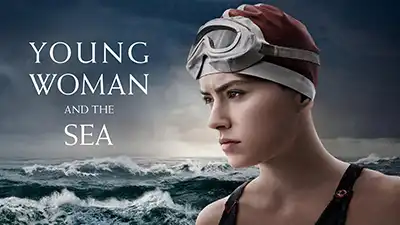Young Woman and the Sea: A Feminist Odyssey Through Waves of Resistance
In 1926, Gertrude "Trudy" Ederle became the first woman to swim the English Channel, defying societal norms, biological limitations, and a world that told her women belonged in kitchens, not oceans. Nearly a century later, Disney’s Young Woman and the Sea (2024) resurrects her story with visceral intensity, transforming a historical footnote into a roaring anthem of feminist resilience. Directed by Joachim Rønning (Pirates of the Caribbean: Dead Men Tell No Tales), the film is less a conventional sports biopic than a searing indictment of patriarchal systems—and a testament to the collective power of women who refuse to drown in silence.
A Sea of Resistance: Trudy’s Fight Against the Tides of Misogyny
The film opens in 1910s New York, where young Trudy (Daisy Ridley) nearly drowns in a harbor fire—a tragedy that claims the lives of women too afraid to jump into the water, shackled by skirts and societal shame. This harrowing prologue sets the stage for a narrative steeped in gendered violence, both literal and systemic. Trudy’s mother, Margaret (a standout performance by Olivia Cooke), recognizes the existential threat of female powerlessness. “If you can’t swim,” she tells her daughters, “you’ll always be at the mercy of men.” This line crystallizes the film’s core thesis: survival, for women, is inherently political111.
Trudy’s journey—from a butcher’s daughter in immigrant-heavy Manhattan to an Olympic athlete and eventual Channel conqueror—is framed as a revolt against a world that dismisses women’s bodies as fragile ornaments. The film’s title, Young Woman and the Sea, echoes Hemingway’s The Old Man and the Sea but subverts its solitary masculinity. Here, the sea is both adversary and ally, a metaphor for the suffocating weight of gendered expectations. When Trudy battles 8-foot waves or venomous jellyfish (rendered in stomach-churning CGI), she isn’t merely fighting nature; she’s slashing through the nets of a society that insists women are “too weak” to navigate open waters710.
The Anatomy of a Feminist Epic: Sisterhood, Sacrifice, and Structural Oppression
Young Woman and the Sea distinguishes itself by refusing to romanticize Trudy’s triumph as a lone-wolf achievement. Instead, it highlights the interconnected struggles of women navigating a man’s world. Three relationships anchor the narrative:
Motherhood as Rebellion: Margaret Ederle, Trudy’s mother, is the film’s unsung hero. In a era when women’s ambitions were confined to domesticity, Margaret sells heirlooms to fund Trudy’s training and confronts her husband’s skepticism with steely resolve. Her quiet defiance—echoed in lines like “I’m not hungry, thank you” when asked to prioritize dinner over her daughter’s dreams—embodies the quiet revolutions of countless marginalized women511.
Sisterhood and Sacrifice: Trudy’s older sister, Meg (Florence Pugh), serves as a haunting counterpoint. A gifted swimmer whose talent is stifled by societal pressures, Meg surrenders to an arranged marriage, symbolizing the era’s brutal trade-offs for women. Yet her later act—swimming ahead of Trudy during a disorienting stretch of the Channel crossing—becomes the film’s most tear-jerking moment. It’s a silent scream of solidarity: If I can’t have my dreams, I’ll fight for yours410.
Mentorship Under Fire: Charlotte Epstein (played by Jodie Comer), Trudy’s coach and founder of the Women’s Swimming Association, is a composite of real-life pioneers. Epstein’s battle against male bureaucrats—who dismiss female athletes as “hysterical”—mirrors broader systemic barriers. Her eventual sidelining underscores the film’s bleak truth: even trailblazers are often erased from history411.
Cinematic Waves: Visual Poetry and Historical Revisionism
Rønning’s direction oscillates between intimate character studies and grand spectacle. Underwater sequences, shot by Oscar-winning cinematographer Claudio Miranda, transform Trudy’s strokes into balletic defiance. One standout scene—a long take of Trudy floating beneath moonlit waves—evokes Virginia Woolf’s The Waves, merging existential solitude with transcendent beauty711.
Yet the film’s aesthetic triumphs are tempered by historical liberties. While Trudy’s Olympic medals and Channel record are factual, the screenplay (by Jeff Nathanson) amplifies villainy for dramatic effect. The male coach’s sabotage—spiking Trudy’s drink with sedatives—is a fictionalized contrivance, drawing ire from historians4. Similarly, the film downplays Trudy’s post-fame struggles, including her near-paralyzing spinal injury and commercial exploitation by her own family410.
These choices, while problematic, serve the film’s mythmaking agenda. By streamlining Trudy’s arc into a triumphalist narrative, Disney sidesteps messy realities to craft a palatable “girl power” parable. Yet the core truth remains: Trudy’s swim was a political act. As one character notes, “The Channel doesn’t care if you’re a woman. But the world does”11.
Legacy in the Shallows: Why This Story Matters Today
Young Woman and the Sea arrives amid global reckonings with gender inequality—from sports pay gaps to reproductive rights rollbacks. Its message transcends period trappings, resonating with modern audiences through haunting parallels. When Trudy battles jellyfish—a real-life ordeal that left her body scarred—the scene mirrors contemporary women enduring online harassment or workplace discrimination: pain inflicted simply for occupying space110.
The film’s climax, where coastal women light bonfires to guide Trudy home, is a masterstroke of visual symbolism. These nameless figures—housewives, suffragettes, factory workers—embody the collective struggle for visibility. Their flames, flickering against a misogynistic night, declare: We see you. We are you511.

Swimming Against the Current
Young Woman and the Sea is imperfect. Its pacing stumbles in the second act, and its villains often feel cartoonishly patriarchal. Yet these flaws pale against its seismic emotional impact. Daisy Ridley’s Trudy is no saint—she’s stubborn, impulsive, and achingly human. Her victory isn’t marked by crowd cheers but by a quiet epiphany: “I did it for them,” she whispers, gazing at the girls who’ll inherit her legacy10.
In an era where “feminist cinema” risks becoming a hollow buzzword, this film demands more. It asks audiences not just to applaud Trudy’s strength but to interrogate why such strength was—and remains—necessary. As the credits roll, we’re left with Trudy’s final words, a challenge as relevant today as in 1926: “The sea doesn’t care if you’re afraid. So why should you?”